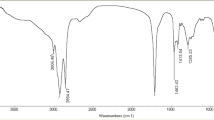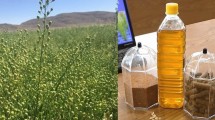Abstract
Biolubricants have received growing interest as potential substitutes to conventional petroleum-based lubricants. Due to their renewability, biodegradability, and superior properties compared with mineral lubricants, they can play a significant role in overcoming some of the global challenges such as dependency on petroleum-based products, reduction in energy consumption, and environmental pollution. The objective of this research is to determine effective factors in biolubricant synthesis from Pistacia atlantica mutica oil as a novel indigenous feedstock which covers more than 1.2 million hectares of jungles in Iran. In this regard, a solid base–catalyzed transesterification reaction was applied in the presence of potassium carbonate as a cost-effective heterogeneous catalyst. The reaction parameters then were optimized using response surface methodology. The optimum values of operating parameters for the reaction were the methyl ester to trimethylolpropane molar ratio of 5:1, a vacuum pressure of 424.5 mmHg, and a catalyst concentration of 1.45 wt.% that resulted in the reaction yield of 82.5%. The physicochemical properties of the final product were evaluated and were comparable with those of the ISO VG-22 reference lubricant standard.

.





Similar content being viewed by others
References
Garcés R, Martínez-Force E, Salas JJ (2011) Vegetable oil basestocks for lubricants. Grasas Aceites 62:21–28. https://doi.org/10.3989/gya.045210
McNutt J, He Q (2015) Development of biolubricants from vegetable oils via chemical modification. J Ind Eng Chem 36:1–12. https://doi.org/10.1016/j.jiec.2016.02.008
Matiliunaite M, Paulauskiene T (2018) From concept to practice: manufacturing of bio-lubricants from renewable resources. Biomass Convers Biorefinery 9:353–361. https://doi.org/10.1007/s13399-018-0356-0
Getliff JM, James SG (1996) The replacement of alkyl-phenol ethoxylates to improve the environmental acceptability of drilling fluid additives. SPE Heal Saf Environ Oil Gas Explor Prod Conf. https://doi.org/10.2118/35982-MS
Neff JM, McKelvie S, Ayers RC (2000) Environmental impacts of synthetic based drilling fluids. US Department of the Interior, Minerals Management Service, Gulf of Mexico OCS Region
Ting CC, Chen CC (2011) Viscosity and working efficiency analysis of soybean oil based bio-lubricants. Measurement 44:1337–1341. https://doi.org/10.1016/j.measurement.2011.04.005
Smith SA, King RE, Min DB (2007) Oxidative and thermal stabilities of genetically modified high oleic sunflower oil. Food Chem 102:1208–1213
Honary LAT, Richter E (2011) Biobased lubricants and greases: technology and products. John Wiley & Sons
Bremmer BJ, Plonsker DL (2011) Biobased lubricants. Surfactants Tribol 2:266–267. https://doi.org/10.1201/b10868-15
Panchal TM, Patel A, Chauhan DD, Thomas M, Patel JV (2017) A methodological review on bio-lubricants from vegetable oil based resources. Renew Sust Energ Rev 70:65–70. https://doi.org/10.1016/j.rser.2016.11.105
Mobarak HM, Niza Mohamad E, Masjuki HH, Kalam MA, al Mahmud KAH, Habibullah M, Ashraful AM (2014) The prospects of biolubricants as alternatives in automotive applications. Renew Sust Energ Rev 33:34–43
Kania D, Yunus R, Omar R, Abdul Rashid S, Mohamad Jan B (2015) A review of biolubricants in drilling fluids: recent research, performance, and applications. J Pet Sci Eng 135:177–184. https://doi.org/10.1016/j.petrol.2015.09.021
Gryglewicz S, Muszyński M, Nowicki J (2013) Enzymatic synthesis of rapeseed oil-based lubricants. Ind Crop Prod 45:25–29. https://doi.org/10.1016/j.indcrop.2012.11.038
Sripada PK, Sharma RV, Dalai AK (2013) Comparative study of tribological properties of trimethylolpropane-based biolubricants derived from methyl oleate and canola biodiesel. Ind Crop Prod 50:95–103. https://doi.org/10.1016/j.indcrop.2013.07.018
Madankar CS, Dalai AK, Naik SN (2013) Green synthesis of biolubricant base stock from canola oil. Ind Crop Prod 44:139–144. https://doi.org/10.1016/j.indcrop.2012.11.012
Aravind A, Joy ML, Nair KP (2015) Lubricant properties of biodegradable rubber tree seed (Hevea brasiliensis Muell. Arg) oil. Ind Crop Prod 74:14–19
Rani S, Joy ML, Nair KP (2015) Evaluation of physiochemical and tribological properties of rice bran oil–biodegradable and potential base stoke for industrial lubricants. Ind Crop Prod 65:328–333
Arbain NH, Salimon J (2010) Synthesis and characterization of ester trimethylolpropane based Jatropha curcas oil as biolubricant base stocks. J Sci Technol 2
Farhoosh R, Tavakoli J, Khodaparast MHH (2008) Chemical composition and oxidative stability of kernel oils from two current subspecies of Pistacia atlantica in Iran. J Am Oil Chem Soc 85:723–729. https://doi.org/10.1007/s11746-008-1258-2
Shanjani PS, Mardi M, Pazouki L, Hagidimitriou M, Avanzato D, Pirseyedi SM, Ghaffari MR, Khayam Nekoui SM (2009) Analysis of the molecular variation between and within cultivated and wild Pistacia species using AFLPs. Tree Genet Genomes 5:447–458. https://doi.org/10.1007/s11295-008-0198-1
Rezaeyan S, Pourmajidian MR, Jalilvand H, Parsakhoo A (2009) Growth parameters of Pistacia atlantica Desf under different soil conditions in Iran. African J Plant Sci 3:184–189
Daneshrad A, Aynehchi Y (1980) Chemical studies of the oil from pistacia nuts growing wild in Iran. J Am Oil Chem Soc 57:248–249. https://doi.org/10.1007/BF02668252
Quinchia LA, Delgado MA, Valencia C, Franco JM, Gallegos C (2011) Natural and synthetic antioxidant additives for improving the performance of new biolubricant formulations. J Agric Food Chem 59:12917–12924. https://doi.org/10.1021/jf2035737
Saboya RMA, Cecilia JA, García-Sancho C, Sales AV, de Luna FMT, Rodríguez-Castellón E, Cavalcante CL Jr (2017) Synthesis of biolubricants by the esterification of free fatty acids from castor oil with branched alcohols using cationic exchange resins as catalysts. Ind Crop Prod 104:52–61. https://doi.org/10.1016/j.indcrop.2017.04.018
Cermak SC, Brandon KB, Isbell TA (2006) Synthesis and physical properties of estolides from lesquerella and castor fatty acid esters. Ind Crop Prod 23:54–64
Yunus R, Fakhru’I-Razi A, Ooi TL et al (2004) Kinetics of transesterification of palm-based methyl esters with trimethylolpropane. J Am Oil Chem Soc 81:497–503. https://doi.org/10.1007/s11746-004-0930-7
Kamil RNM, Yusup S, Rashid U (2011) Optimization of polyol ester production by transesterification of Jatropha-based methyl ester with trimethylolpropane using Taguchi design of experiment. Fuel 90:2343–2345. https://doi.org/10.1016/j.fuel.2011.02.018
Wang E, Ma X, Tang S, Yan R, Wang Y, Riley WW, Reaney MJT (2014) Synthesis and oxidative stability of trimethylolpropane fatty acid triester as a biolubricant base oil from waste cooking oil. Biomass Bioenergy 66:371–378. https://doi.org/10.1016/j.biombioe.2014.03.022
Bakar AA, Yunus R, Chuah AL, Fakhru’l-Razi A (2007) Study on effect of hydroxyl group on lubrication properties of TMP esters.pdf. J Appl Sci 7:2011–2014
Gunam Resul MFM, Tinia TI, Idris A (2012) Kinetic study of jatropha biolubricant from transesterification of jatropha curcas oil with trimethylolpropane: effects of temperature. Ind Crop Prod 38:87–92. https://doi.org/10.1016/j.indcrop.2012.01.012
Erhan SZ, Adhvaryu A, Sharma BK (2005) Chemically functionalized vegetable oils. In: Synthetics, mineral oils, and bio-based lubricants: chemistry and technology. CRC Press
Hajar M, Vahabzadeh F (2016) Biolubricant production from castor oil in a magnetically stabilized fluidized bed reactor using lipase immobilized on Fe3O4 nanoparticles. Ind Crop Prod 94:544–556. https://doi.org/10.1016/j.indcrop.2016.09.030
Sun G, Li Y, Cai Z, Teng Y, Wang Y, Reaney MJT (2017) K 2 CO 3 -loaded hydrotalcite: a promising heterogeneous solid base catalyst for biolubricant base oil production from waste cooking oils. Appl Catal B Environ 209:118–127. https://doi.org/10.1016/j.apcatb.2017.02.078
Zaccheria F, Mariani M, Psaro R, Bondioli P, Ravasio N (2016) Environmentally friendly lubricants through a zero waste process. Appl Catal B Environ 181:581–586. https://doi.org/10.1016/j.apcatb.2015.08.032
Nie J (2012) Synthesis and evaluation of polyol based biolubricants from vegetable oils. Dep. Food Bioprod. Sci. Master
Samani BH, Zareiforoush H, Lorigooini Z, Ghobadian B, Rostami S, Fayyazi E (2016) Ultrasonic-assisted production of biodiesel from Pistacia atlantica Desf. oil. Fuel 168:22–26
Metcalfe LD, Schmitz AA, Pelka JR (1966) Rapid preparation of fatty acid esters from lipids for gas chromatographic analysis. Anal Chem 38:514–515
Chai M, Tu Q, Lu M, Yang YJ (2014) Esterification pretreatment of free fatty acid in biodiesel production, from laboratory to industry. Fuel Process Technol 125:106–113
Jaggernauth-Ali P, John E, Bridgemohan P (2015) The application of calcined marlstones as a catalyst in biodiesel production from high free fatty acid coconut oil. Fuel 158:372–378
Fraile M, Gil L, Herrerías CI, Angulo B (2018) Bio-lubricants production from fi sh oil residue by transesteri fi cation with trimethylolpropane. 202:. https://doi.org/10.1016/j.jclepro.2018.07.260
Khuri AI, Mukhopadhyay S (2010) Response surface methodology. WIREs Comp Stat 2:128–149. https://doi.org/10.1002/wics.73
Sabzimaleki M, Ghobadian B, Mazloom Farsibaf M, Najafi G, Dehghani Soufi M, Mohammad Safieddin Ardebili S (2015) Optimization of biodiesel ultrasound-assisted synthesis from castor oil using response surface methodology (RSM). Chem Prod Process Model 10:123–133. https://doi.org/10.1515/cppm-2014-0013
Hamid HA, Yunus R, Rashid U, Choong TSY, Ali S, Syam AM (2016) Synthesis of high oleic palm oil-based trimethylolpropane esters in a vacuum operated pulsed loop reactor. Fuel 166:560–566. https://doi.org/10.1016/j.fuel.2015.11.022
Chang T-S, Masood H, Yunus R, Rashid U, Choong TSY, Biak DRA (2012) Activity of calcium methoxide catalyst for synthesis of high oleic palm oil based trimethylolpropane triesters as lubricant base stock. Ind Eng Chem Res 51:5438–5442
Menkiti M, Anaehobi H, Oyoh K, Nnaji P (2015) Process optimization and kinetics of biolubricant synthesis from fluted pumpkin seed. Eur Sci J 11:
Silva JAC, Habert AC, Freire DMG (2013) A potential biodegradable lubricant from castor biodiesel esters. Lubr Sci 25:53–61
Acknowledgments
The authors express their thankful regards for Prof. Paolo Bondioli, the head of the Oils, Fats, and Derivatives Department of Milan INNOVHUB-SSI-SSOG Institute for his review and constructive feedbacks and our colleagues from TMU Renewable Energies Research Institute who provided insight and expertise that greatly assisted this research.
Author information
Authors and Affiliations
Corresponding author
Additional information
Publisher’s Note
Springer Nature remains neutral with regard to jurisdictional claims in published maps and institutional affiliations.
Rights and permissions
About this article
Cite this article
Mehdi, S., Asghari, A., Ghobadian, B. et al. Conversion of Pistacia atlantica mutica oil to trimethylolpropane fatty acid triester as a sustainable lubricant. Biomass Conv. Bioref. 10, 139–148 (2020). https://doi.org/10.1007/s13399-019-00452-y
Received:
Revised:
Accepted:
Published:
Issue Date:
DOI: https://doi.org/10.1007/s13399-019-00452-y




